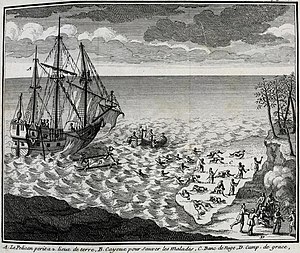Battle of Hudson's Bay
| Battle of Hudson's Bay | |||||||
|---|---|---|---|---|---|---|---|
| Part of the Nine Years' War | |||||||
 The Sinking of the Pélican, after a 1722 print by Claude-Charles Bacqueville de La Potherie |
|||||||
|
|||||||
| Belligerents | |||||||
|
|
|
||||||
| Commanders and leaders | |||||||
| Pierre Le Moyne d'Iberville | John Fletcher | ||||||
| Strength | |||||||
|
3 frigates
|
||||||
| Casualties and losses | |||||||
| 1 ship damaged and later lost | 1 ship sunk 1 ship captured |
||||||
3 frigates
The Battle of Hudson's Bay, also known as the Battle of York Factory, was a naval battle fought during the War of the Grand Alliance (known in England's North American colonies as "King William's War"). The battle took place on 5 September 1697, when a French warship commanded by Captain Pierre Le Moyne d'Iberville defeated an English squadron commanded by Captain John Fletcher. As a result of this battle, the French took York Factory, a trading post of the Hudson's Bay Company. For other fighting in the region see Anglo-French conflicts on Hudson Bay.
D'Iberville's flagship, Pélican (44-guns), was part of a larger French squadron dispatched to contest English control of Hudson Bay. D'Iberville commanded Le Pélican (50 [44] cannons, captain Pierre Le Moyne d’Iberville), a 3rd rate man-of-war cut for fifty guns, and with one hundred and fifty men ship's company. Serigny commanded the Le Profond (frigate/‘storeship’) (460 t, flûte de 32 canons [+2 from Le Pélican], commanded by Pierre Du Gué, Sieur de Boisbriand.). Boisbriant commanded Le Vesp/Weesph (frigate) (Capt. Chatrie (chevalier de Chastrier) a vessel of about 300 t with about 20–26 guns). Le Palmier (frigate) (5th rate man-of-war, 300t, captain Joseph Le Moyne de Serigny) a vessel of about 20–26 guns, and originally the "Violent" renamed L'Esquimau/Esquimaux (the Eskimo), a supply ship (150 ton brigantine) Jean Outelas, Capt., capable of carrying from 10–12 guns; one report says the last was crushed by the ice pack
Before the battle, Pélican became separated from the rest of the French squadron in heavy fog, but D'Iberville elected to forge ahead. This set the stage for a little-known but spectacular single-ship action against heavy odds.
As Pélican sailed south into clearer weather, she approached the trading post of York Factory, and a group of soldiers went ashore to scout out the fort. Captain D'Iberville remained on board Pélican. While the shore party was scouting the fort, D'Iberville saw the sails and masts of approaching ships. Thinking the rest of his squadron had arrived, he set off to meet them. D'Iberville realized that the ships were not French, but were, instead, an English squadron when one fired a shot across the bow of Le Pélican.
...
Wikipedia
